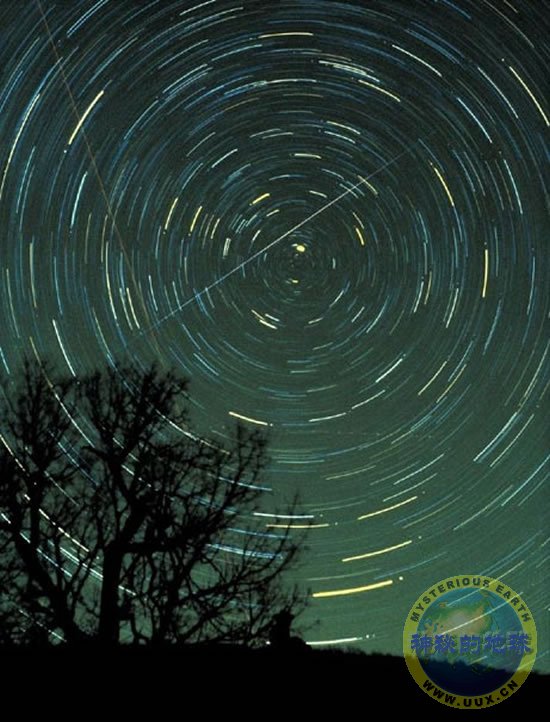"Year's Best" Meteor Shower to Peak December 13-14
A Geminid meteor streaks across swirling stars in a time-elapsed photo taken on Georgia's Brasstown Bald Mountain in 1985.
In what astronomers are calling the year's best sky show, the annual Geminid shower will peak on December 13 and 14, 2007.
Photograph by Jimmy Westlake, courtesy NASA
Anne Minard
for National Geographic News
December 10, 2007
The Geminid meteor shower—considered by many to be the most active annual sky show—is going to be especially spectacular this year, astronomers predict.
The show gets its name from the constellation Gemini, because the meteors appear to stream from near the constellation's bright star Castor.
Unlike last year, the Geminids will be falling against a dark, moonless night.
The last time the sky was this dark during the shower was in 1996, when observers saw up to 110 meteors an hour.
Experts say the rate will be at least that high this year, with peak viewing on December 13 and 14.
"Since the August Perseid shower has been declining the last couple of decades, the Geminids are now the best annual meteor shower," said Brian Skiff, a researcher at Lowell Observatory in Flagstaff, Arizona.
(Related: "Perseid Meteor Shower to Peak This Weekend" [August 10, 2007].)
And this year the meteors will be joined by an exceptionally bright Mars visible in Gemini. The planet will be gleaming yellow-orange as it nears a close approach to Earth.
Weird Source
Most annual meteor showers occur when Earth passes through fields of debris left behind by orbiting comets. Researchers can therefore tie a particular shower to a known comet.
Although the Geminids were first noticed in the mid-1800s, scientists didn't locate their source until 1983.
Co-discoverers Simon Green, now at the Open University in the United Kingdom, and John Davies, now at the Royal Observatory in Edinburgh, pinned the yearly show to a mysterious object called 3200 Phaethon.
At first astronomers were not sure if the object was an asteroid or a comet.
Asteroids are conventionally thought to form from rock in the warmer, inner areas of the solar system, while comets are made of rock and ice in colder, more distant regions.
On the surface 3200 Phaethon looks like a rocky asteroid. But an asteroid that creates meteor showers like a comet would be an extremely rare find.
Most astronomers now believe the Geminids' source is an extinct comet thats collected a thick outer layer of interplanetary dust—a comet in an asteroid's clothes.
Best Seats
The Geminid shower wasn't always such a spectacular show. Viewers of its first appearance more than a century ago recorded only 10 to 20 meteors an hour.
What's more, the Geminids approach Earth at the relatively slow speed of 22 miles (35 kilometers) a second.
By comparison, November's annual Leonid shower speeds through our atmosphere at about 44 miles (71 kilometers) a second.
But the December display has been increasingly outcompeting all other yearly meteor showers, experts say.
The best places to watch will be in central Asia and eastward, across the Pacific Ocean to Alaska.
Stellar performances will be visible six to ten hours around the precise peak on December 14 at 11:45 a.m. EST, astronomers say, so stargazers in North America will get almost as good a show.
As for 3200 Phaethon's co-discoverer Green, he says cloudy skies over the U.K. have prevented him from seeing the Geminids in most years.
When he does catch a glimpse, he said, "I just stand and watch and think of the little bits of 'my' asteroid that are burning up in the skies above."












